Perhaps thirty vinyards participate in this eating/drinking/tasting spree and there are shuttle buses arranged to take the topers on a tour of these - alternatively, you can get hold of a map showing all the locations and drive yourself around. Be advised, though, that the local blue boys will be out on the roads, armed with breathalyzers, ticket pads and sharp pencils. Or you can do as we did, simply drive along until you happen upon the roadside signs informing of a winery. We didn't stop off at many, thinking it unwise to tempt the Fates - driving on the right, meaning the wrong, side of the road might have happened - and in any case we were looking for sources of Tokay (Tokai or Tokaj if you're a purist) at a price so that we could reasonably afford at least one bottle - at the last hunt for this delectable wine, it would have set us back a cool $1030 for a half-bottle ! Did we find any Tokay ? You'll have to guess at the answer because I'm not telling and there certainly wouldn't be any left by now !
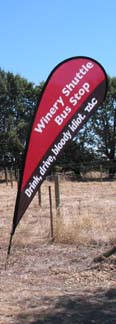
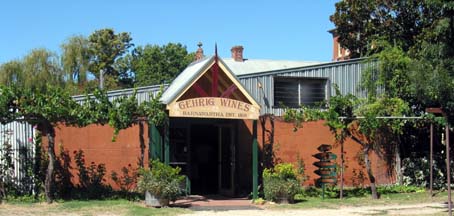
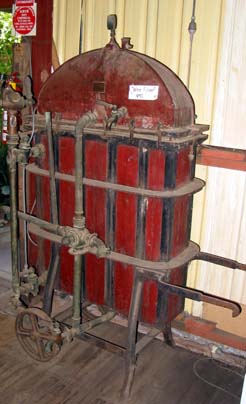
This is one of the smaller wineries, specialising in Tokay, established 1858, and one of their old winefilters, 1890.
Rutherglen is the point at which the east-bound traveller leaves the flat Murray River valley and starts to make a long climb up into the Australian Alps. We could see the hills in the distance, smoky blue as are the Blue Mountains further to the north, and at Wodonga the road started to climb in earnest. By the time we reached Lake Hume, the scenery was almost alpine. Lake Hume is a largely artificial lake, not very deep but with a sizeable area and its purpose was to hold back winter rains for irrigation purposes. About 1920, it was decided to build a major dam here, at the confluence of the Mitta Mitta and Murray Rivers to provide this major water resource - the town of Tallangatta was eventually threatened and in the 1940s the decision was taken to move the whole town, lock and barrel (to say nothing of the railway line) to higher ground and this work was eventually completed in 1956.
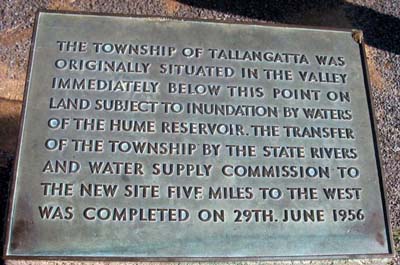
Present-day Talangatta is a delightful little town with a magnificant view of the southerly portion of Hume Lake. The past decade or so's droughts have so reduced the water level that not only has the old town reappeared above the waters but (New) Talangatta has lost its acess to the very large waterway.

Map of (Old) Talangatta - compare with the panorama photograph below, showing the dried-out town foundations.

Lake Hume and (New) Talangatta lie to the left - centre is (Old) Talagatta, a lake two decades ago. Australian Alps to the right.
Upward, ever upward, gallant Gertie ground her way, up steeper and steeper and steeper roads, past Corryong, home of The Man from Snowy River (and, boy, do they make a lot of that in the town !) and across the Murray River for the last time. The Hume irrigation scheme pales beside the imaginative Snowy Mountains power/irrigation project - in Victoria we had seen irrigation carried out using essentially covered canals to prevent evaporative losses, but here, huge dams and through-mountain tunnels divert whole rivers under the earth. We followed the steep twisting road NE to and from Cabramurra which surely must be the highest town in Australia, past and across Tooma Dam.
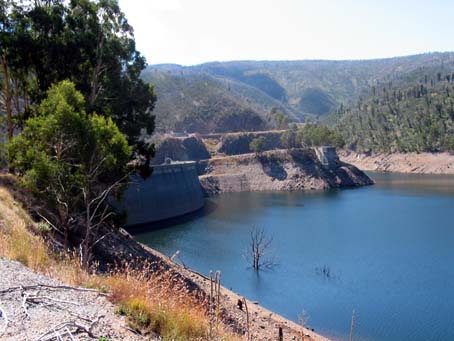
This is a part of the huge Snowy Mountains Scheme - notice how depleted is the reservoir.
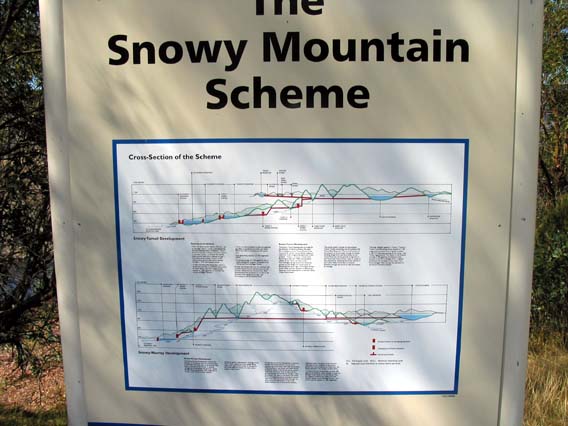
There are essentially two separate parts to the scheme - upper is the Snowy-Tumut River Scheme - lower is the Snowy-Murray River Scheme. We went up the Murray (lower diagram) and down the Tumut (upper diagram). Are you sufficiently confused ? Looking at the upper part, we started at the extreme top right, took a diversion to Tooma Dam (very top, left offshoot) and then continued downhill, to finish at Blowering Reservoir and its dam (extreme left).
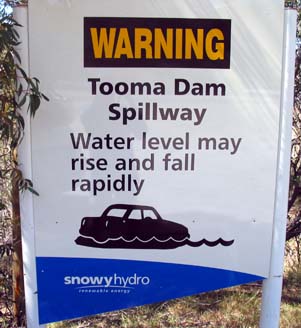
No joke !
After Cabramurra, we joined the Snowy Mountains Highway and the road improved somewhat (fewer dire warnings about road closures during winter, guard rails at the vertiginous road edges and so on) and eventually arrived at the bottom, Blowering Reservoir.

The reason Gertie is parked here is because it's a good half-mile to the water from our camp site and we wanted to take a swim in what remained of the lake - this place is called Yachting Point. A few dozen wallabies were hanging around to enjoy that sight and further on, we arrived at the final dam of this portion of the Snowy Scheme and could look back up the 20 km or so of the lake.
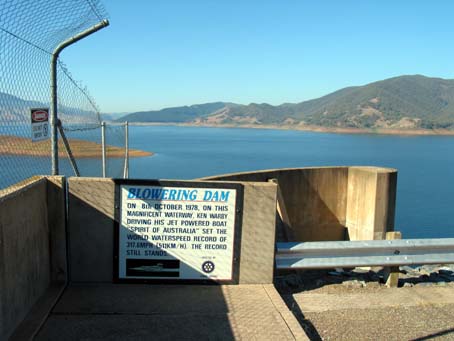
It was a swift dash from here through Tumut, Gundegai, Murrumburrah and Cowrah all the way to Bathurst, NSW. This is the city where once they put the least desirable deported convicts - a long way and over the mountains from the coast and possible escape. Bathurst is a prosperous-looking city with elaborate buildings built by, you guessed it, convict labour and originally surrounded by prosperous farms owned by the military upper ranks and worked by, you guessed it, convict labour. It's also the home of the Mount Panorama motor racing circuit and that makes weekends in the city occasionally very noisy....... But they had just opened the Begonia House, where any begonia grower could gaze and drool.
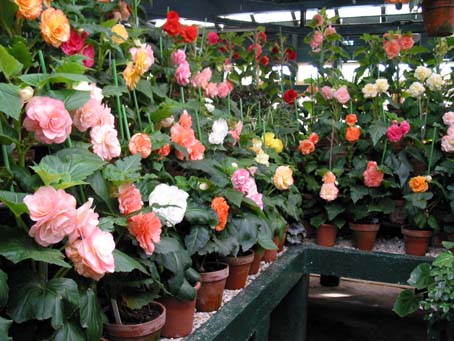
These blooms are 6"-12" across !
We were staying with relatives in Bathurst (thanks, Mick and Susan) for a couple of days and made a visit to a little town not too far away, Millthorpe, where Time seemed to have stood still for almost a century. Made the obligatory visit to the Town Museum with its large collection of past-technology. Maybe someone can comment on this so-interesting device, precursor of the refrigerator I suppose - more to the point, I personally don't agree with the explanation provided of its workings.
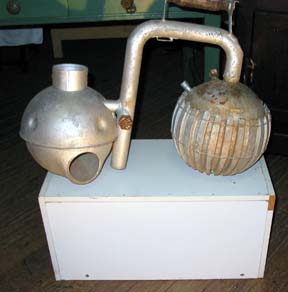
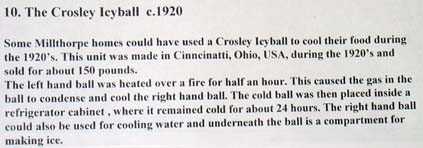
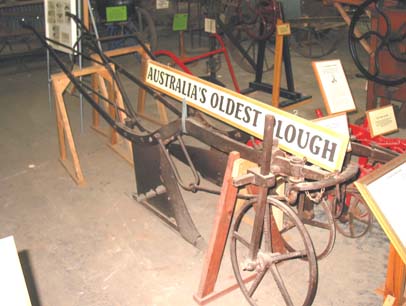
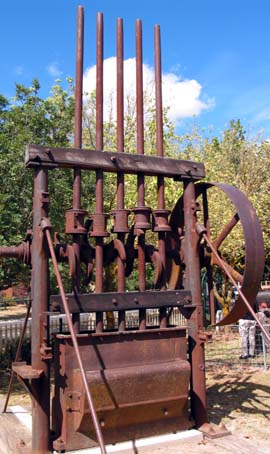
I'm not sure this is a valid claim of Australia's oldest plough...........but here's a gold ore stamper in great shape - they're restoring the original steam engine for it, recently acquired. Unfortunately, the stamper will have to be moved in order to accommodate its driving power.
Bathurst was cool. In the temperature sense, that is. It even snows here sometimes - and how those convicts must have loved that, up in the rareified air of the plateau, with not much to look forward each day except maybe the chance of getting out in the open air as part of a chain gang and only bread and water if the day's quota wasn't completed. Not much bread at that although there's lots of water in Bathurst - we refilled Gertie's water tanks here and then took off, downhill all the way toward Sydney. and then northwards on the fast Pacific Highway to Toronto, NSW. Here we stopped off again for an extended stay at Rosco ( www.roscoclub.org ) for a certain amount of rest and recuperation.We got into the habit of playing petanque at least once a day, even though the Australian game is played just anywhere, that is, not just on a carefully-groomed court such as you'll find in Canada and particularly in Quebec so that perhaps our technique has suffered a bit. Also, certain experiments in Levitation were undertaken.
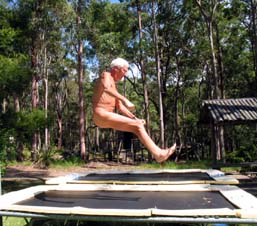
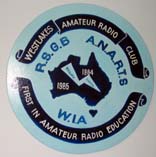
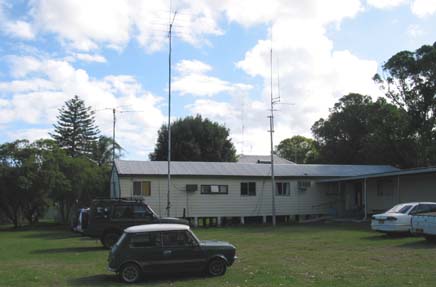
This shows just a few of the antennas at the clubhouse.
The clubhouse is well-equipped and obviously has an active program, instructional (they have a dedicated classroom here), experimental (I walked in upon a group developing and tuning quarter-wave stubs as notch filters to eliminate TVI which has been annoying your neighbour) social (full kitchen for hot dogs, hamburgers and tea - not coffee) and service (they run the Australian QSL bureau here, and this is where all those DX QSL cards are handled).

The well set-up class room.
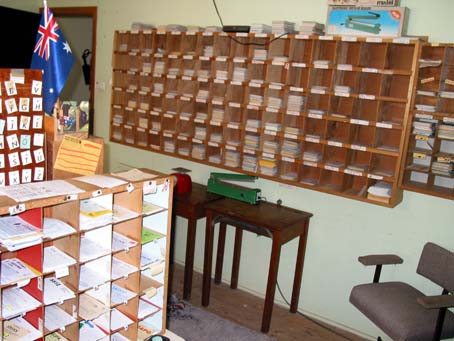
A part of the Australian QSL bureau.
It was a very pleasant visit to an obviously thriving ARC and I'm grateful to its members for all the assistance in using their repeater.
At Rosco, we continued our daily routine - frequent swims in the solar pool and chivvying the wallabies which came to feast on the lawns. There were also the annoying oppossums who were determined to haul off any foodstuffs left unlocked and the even more annoying kookaburras who dive bombed us during meals. The flowers of early autumn were spectacular.
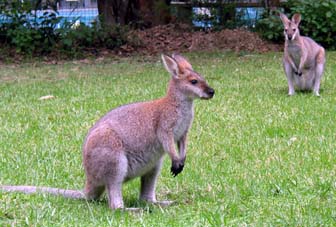
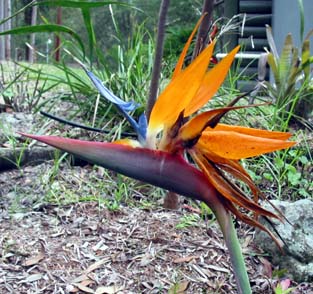
Wallabies hopping around the swimming pool.................................The interesting Bird of Paradise flower.
Weekends saw an influx of Rosco members and then there were the daily "Happy Hour" meetings at 5 pm daily, depending upon who happened to be around - one saturday night, a very well-attended Fancy Dress Party - perhaps Fancy Dress sounds a bit bizarre for a nudist club, but bear in mind that it's getting a bit cool here at night time. We heard about Ottawa's record-setting plus 22 C daytime temperature one night just as we were complaining about the fact that the temperature here had fallen down to the same figure at the same time. Depend upon it, in May, when we shall return, there will be a record-setting low.......
Rosco club is getting concerned about the size of its gum trees - these have the habit of suddenly, with no prior warning, dropping sizeable branches and woe to anyone who is beneath. Recently, at least one caravan has been severely damaged as a result. The club is situated within the provenance of a State Forest and, while this has quite obvious advantages, it does mean that indiscriminate cutting of timber is strictly forbidden and a lengthy process of justification and inspection must be carried out prior to the expensive business of felling and treating dangerous trees. Here is Gertie underneath the gum trees the day we left Rosco for Port Macquarie, last stage of our return home.
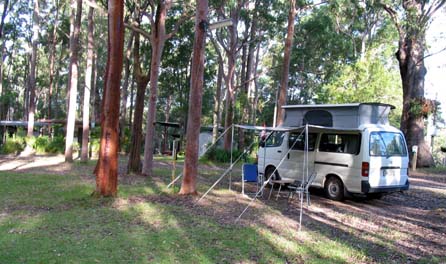
It was a rapid journey N. to Port Macquarie, continuing up the Pacific Highway, and we intended to stop off at Nabiac to visit the Australian Motorcycle Museum - recall (see the Diary entry for Feb 10) that this had been flooded and so was closed when we'd been travelling S. on the same route just after Xmas. If you're a motorcycle afficionado or even if you're only a sociologist tracing the demise of the British motorcyle industry through a combination of laziness and mismanagement, then this is one place to visit. Here's a view of perhaps a fifth of the 800 or so motorbikes collected here, some in mint condition, some in process of restoration and some of fascinating historical interest.
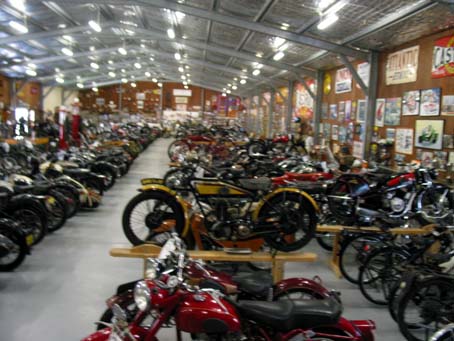
Well, I have about fifty photos of interesting 'bikes but here are two which hold an especially appeal for me.
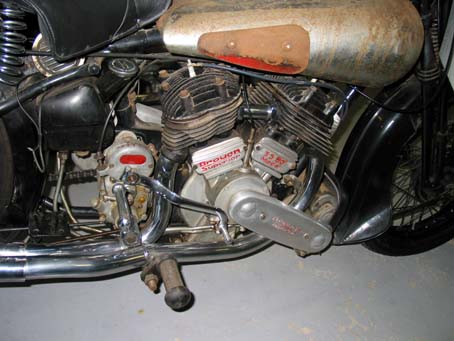
This is a Brough Superior, a motorbike far ahead of its time (see "The Mint" by T.E. Lawrence).....
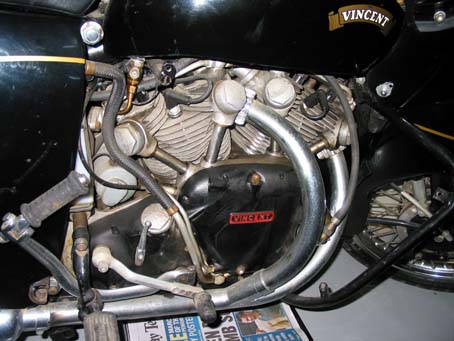
....and this is a Vincent Black Knight, the finest 'bike which I ever owned ! See the engine's resemblance ?
After two and a half hours drooling over motor cycles, we had to leave and push on for Port Macquarie where we were to stay for the next two weeks. Looking forward to returning home via Vancouver and, who knows, maybe a bit of skiing at Whistler.....